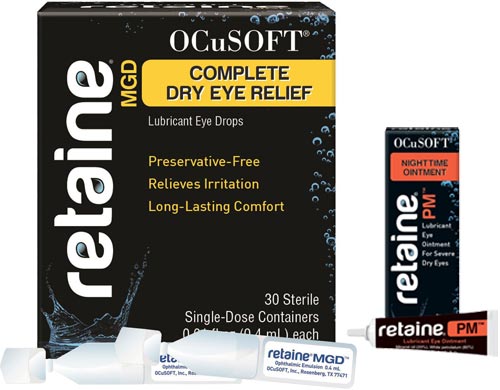|
|
| |
| |
Dry eye is a medical condition that affects an
estimated 20 million people in the United States alone. Dry eye most
often results from inadequate lubrication of the eye. Symptoms may
be occasional discomfort or chronic and potentially
vision-threatening, whether mild or painful. Only your eye care
professional can properly diagnose your dry eye problem.
|
|
 |
The Importance of Eye
Lubrication:
Tears and Tear Film
Good vision starts with a good tear film that must
constantly be produced and spread over our eyes to keep
them moist.
Tear film:
 Bathes, refreshes and protects the surface of the eye
from the irritating effects of dirt, dust, and other
airborne particles
Bathes, refreshes and protects the surface of the eye
from the irritating effects of dirt, dust, and other
airborne particles
 Protects from infection
Protects from infection
 Helps to create a smooth surface so vision stays clear
and undistorted
Helps to create a smooth surface so vision stays clear
and undistorted
 Keeps eyes lubricated and comfortable
Keeps eyes lubricated and comfortable
If you have an abnormal or deficient tear film, the
quality of your vision may be diminished.
Tears are made
up of 3 components: lipid, aqueous and mucins. and they must be in balance to create the moisture
that keeps our eyes comfortable. If any
is missing or damaged, the tear film is
compromised and the eye moisture will be depleted
causing the eyes to feel dry and irritated. |
Chronic dry eye can occur when the tear glands don't produce the
right quantity/quality of tears to keep the eyes lubricated and
protected.
Retaine MGD is the ONLY Fourth Generation
Tear Available.
Lipid-replenishing formula utilizes
electrostatic attraction to stabilize the tear film and
protect against
moisture loss. Preservative-Free.
Retaine PM is designed to keep eyes
lubricated and comfortable while you sleep. Retaine PM is a
preservative-free, oil-based formula that is conveniently
packaged in a 3.5gm tube. For nighttime use only |
Chronic Dry Eye
Blinking spreads the tear film over the eye. If the tear film is
inadequate, dry spots can occur causing discomfort and damage to the
corneal cells on the surface of the eye. You may not know that you
have damaged corneal cells but your eyes may feel dry with a burning
sensation. Your eye care professional will be able to see the surface
damage during an eye exam.
Corneal cells can heal quickly if they are diagnosed early and
treated with a dry eye lubricant that protects the cells and allows
moisture to remain on the surface longer.
Common Causes of Dry Eye
There are many causes of Dry Eye. These can be attributed to a
number of different factors:
Aging: As we grow older, our eyes produce tears that have less
natural oil in them.
Menopause: Females entering menopause are among the most prone to
dry eye.
Autoimmune Disorders: Diseases such as rheumatoid arthritis, lupus,
multiple sclerosis, thyroid and Sjogren's syndrome can cause
inflammation in the tear-producing lacrimal gland.
Environment: Excessive heat or air conditioning, fans, dry or windy
climates, smoke, airplanes, and lack of sleep can all cause dry eye.
Work Environment: Outside wind, dust, heat, or smog can cause dry
eye. Focusing on a computer screen for extended periods is also a
common cause.
Medications: Numerous medications can cause dry eye. Be sure to tell
your eye care professional about all the medications you are taking.
Eye Medications: Preservatives in artificial tears and
anti-glaucoma drops may be toxic to the cells on the surface of the
eye and contribute to dry eye
Contact Lens Wear: Wearing contact lenses can contribute to dry eye. |
| |
|
|